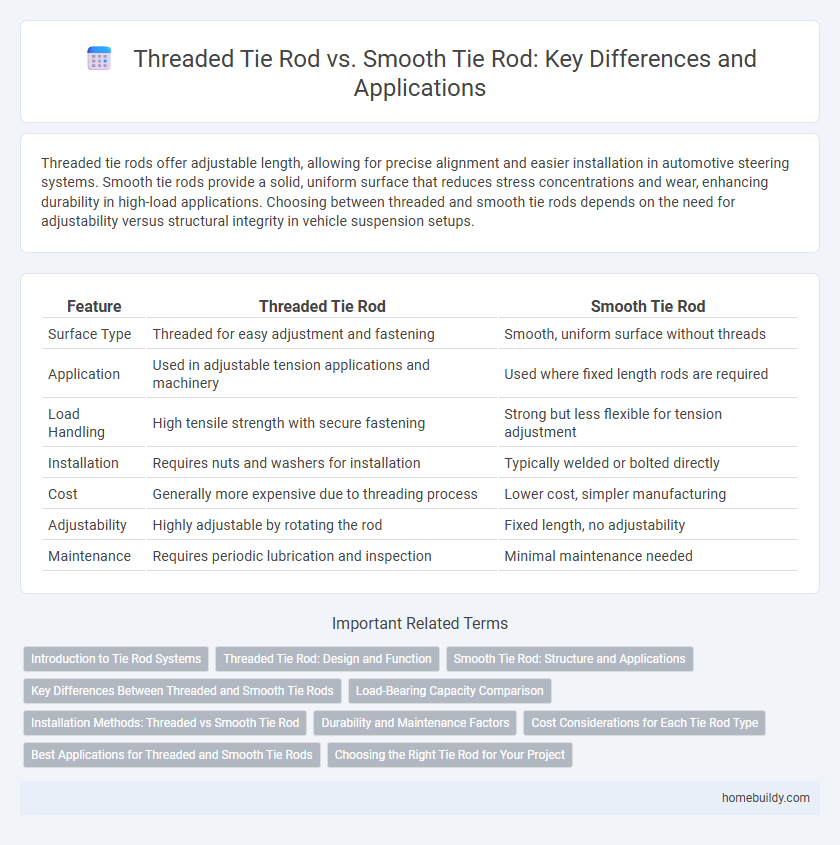Threaded tie rods offer adjustable length, allowing for precise alignment and easier installation in automotive steering systems. Smooth tie rods provide a solid, uniform surface that reduces stress concentrations and wear, enhancing durability in high-load applications. Choosing between threaded and smooth tie rods depends on the need for adjustability versus structural integrity in vehicle suspension setups.
Table of Comparison
| Feature | Threaded Tie Rod | Smooth Tie Rod |
|---|---|---|
| Surface Type | Threaded for easy adjustment and fastening | Smooth, uniform surface without threads |
| Application | Used in adjustable tension applications and machinery | Used where fixed length rods are required |
| Load Handling | High tensile strength with secure fastening | Strong but less flexible for tension adjustment |
| Installation | Requires nuts and washers for installation | Typically welded or bolted directly |
| Cost | Generally more expensive due to threading process | Lower cost, simpler manufacturing |
| Adjustability | Highly adjustable by rotating the rod | Fixed length, no adjustability |
| Maintenance | Requires periodic lubrication and inspection | Minimal maintenance needed |
Introduction to Tie Rod Systems
Threaded tie rods offer precise adjustability and secure connections through their helical ridges, making them ideal for applications requiring tension control and fine-tuning. Smooth tie rods provide consistent surface contact and are commonly used in systems where uniform load distribution and minimal friction are essential. Tie rod systems rely on these components to maintain structural integrity by transmitting tensile forces in construction, automotive suspension, and machinery applications.
Threaded Tie Rod: Design and Function
Threaded tie rods feature continuous or intermittently threaded shafts, enabling precise adjustment and secure fastening in construction and mechanical applications. Their design allows for easy assembly and disassembly, providing reliable tension control and alignment in structural frameworks. Commonly made from high-strength steel, these rods ensure durability and load-bearing capacity in various load transfer and stabilization tasks.
Smooth Tie Rod: Structure and Applications
Smooth tie rods feature a uniform, cylindrical shaft without threading, providing consistent tensile strength and reduced stress concentration compared to threaded alternatives. Their smooth surface enhances load distribution and minimizes wear in applications such as automotive steering systems, industrial machinery, and structural support frameworks. Commonly used where precise adjustment is less critical, smooth tie rods deliver durability and reliability in high-load environments.
Key Differences Between Threaded and Smooth Tie Rods
Threaded tie rods feature continuous or partially threaded cylindrical rods designed for adjustable length and secure fastening using nuts, allowing precise tension control in structural applications. Smooth tie rods have unthreaded, uniform shafts, providing higher shear strength and resistance to fatigue but lack adjustability, making them ideal for fixed-length connections requiring robust stability. The choice between threaded and smooth tie rods depends on load requirements, adjustability needs, and the nature of the construction or mechanical system.
Load-Bearing Capacity Comparison
Threaded tie rods offer superior load-bearing capacity due to their precise adjustability and ability to securely fasten components, ensuring optimal tension distribution. Smooth tie rods have limited load tolerance as they lack the threaded surface needed for secure anchoring, which can lead to slippage under heavy loads. The mechanical advantage of threaded tie rods makes them ideal for construction and mechanical applications demanding high strength and reliability.
Installation Methods: Threaded vs Smooth Tie Rod
Threaded tie rods require precise alignment during installation to ensure the threads properly engage with corresponding nuts or anchors, often requiring torque wrenches for secure fastening. Smooth tie rods typically utilize clamping or welding methods, enabling faster installation but demanding accurate positioning to maintain structural integrity. Installation of threaded tie rods allows for adjustable tension, whereas smooth tie rods rely on fixed positioning for load transfer.
Durability and Maintenance Factors
Threaded tie rods offer enhanced adjustability, allowing for precise tensioning which aids in maintaining alignment and extending their lifespan under dynamic loads. Smooth tie rods, while simpler and less prone to thread damage, may require more frequent inspections due to potential wear at the attachment points. Durability considerations favor threaded tie rods in applications subject to variable stresses, whereas smooth tie rods often benefit from easier cleaning and reduced maintenance complexity.
Cost Considerations for Each Tie Rod Type
Threaded tie rods typically cost more due to the added machining and threading processes required for precise fit and adjustability. Smooth tie rods are generally less expensive, offering a simpler manufacturing process and suitability for applications where customization is minimal. Choosing between threaded and smooth tie rods depends on budget constraints and the need for adjustment capabilities in the structural application.
Best Applications for Threaded and Smooth Tie Rods
Threaded tie rods offer superior adjustability and secure fastening, making them ideal for applications requiring precise tension control such as structural frameworks and machinery alignment. Smooth tie rods excel in environments where corrosion resistance and ease of installation are prioritized, commonly used in suspension systems and lightweight construction. Selecting between threaded and smooth tie rods depends on load requirements, environmental conditions, and the need for adjustment or replacement flexibility.
Choosing the Right Tie Rod for Your Project
Threaded tie rods offer precise adjustability and secure fastening, making them ideal for projects requiring tension control and alignment accuracy. Smooth tie rods provide a clean, uniform surface suitable for applications emphasizing aesthetic appeal or where welding is necessary. Selecting the right tie rod depends on load requirements, adjustment needs, and installation methods to ensure structural integrity and project success.
threaded tie rod vs smooth tie rod Infographic

 homebuildy.com
homebuildy.com